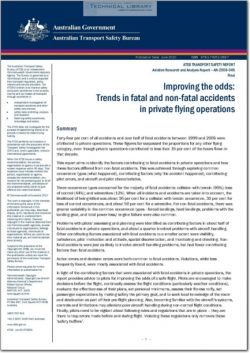ATSB-AR-2008-045

- Version
- 136 Downloads
- 1.96 MB File Size
- 1 File Count
- August 9, 2016 Create Date
- August 9, 2016 Last Updated
Improving the odds; Trend in Fatal and Non Fatal Accidents in Private Flying Operations

Forty-four per cent of all accidents and over half of fatal accidents between 1999 and 2008 were
attributed to private operations. These figures far surpassed the proportions for any other flying
category, even though private operations contributed to less than 15 per cent of the hours flown in
that decade.
This report aims to identify the factors contributing to fatal accidents in private operations and how
these factors differed from non—fatal accidents. This was achieved through exploring common
occurrence types (what happened), contributing factors (why the accident happened), contributing
pilot errors, and aircraft and pilot characteristics.
Three occurrence types accounted for the majority of fatal accidents: collision with terrain (90%); loss
of control (44%); and wirestrikes (12%). When all incidents and accidents are taken into account, the
likelihood of being killed was about 36 per cent for a collision with terrain occurrence, 30 per cent for
loss of control occurrences, and about 50 per cent for a wirestrike. For non—fatal accidents, there was
greater variability in the common occurrence types — forced landings, hard landings, problems with the
landing gear, and total power loss/ engine failure were also common.
Problems with pilots’ assessing and planning were identified as contributing factors in about half of
fatal accidents in private operations, and about a quarter involved problems with aircraft handling.
Other contributing factors associated with fatal accidents to a smaller extent were visibility,
turbulence, pilot motivation and attitude, spatial disorientation, and monitoring and checking. Non-
fatal accidents were just as likely to involve aircraft handling problems, but had fewer contributing
factors than fatal accidents.
Action errors and decision errors were both common to fatal accidents. Violations, while less
frequently found, were mostly associated with fatal accidents.
In light of the contributing factors that were associated with fatal accidents in private operations, the
report provides advice to pilots for improving the odds of a safe flight. Pilots are encouraged to make
decisions before the flight, continually assess the flight conditions (particularly weather conditions),
evaluate the effectiveness of their plans, set personal minimums, assess their fitness to fly, set
passenger expectations by making safety the primary goal, and to seek local knowledge of the route
and destination as part of their pre-flight planning. Also, becoming familiar with the aircraft’s systems,
controls and limitations may alleviate poor aircraft handling during non-normal flight conditions.
| File | Action |
|---|---|
| ATSB-AR-2008-045 Improving the odds; Trend in Fatal and Non Fatal Accidents in Private Flying Operations.pdf | Download |
Comment On This Post